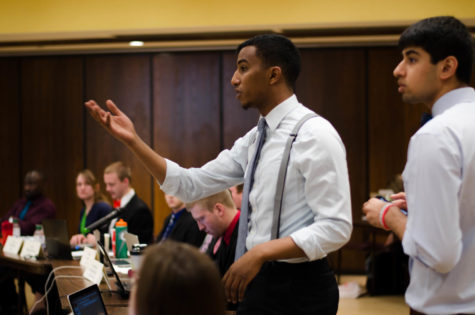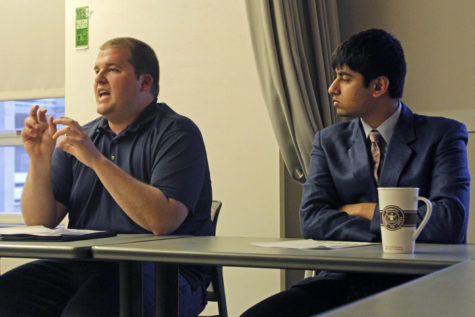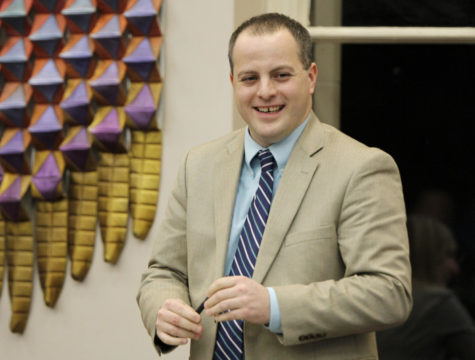Change in control expected to have minor effect on union
February 20, 2003
Editor’s Note: This is the second article in a three-part series about the past, present and future of Iowa State’s Memorial Union.
Although the Memorial Union has been student-owned since its conception in 1919, the union is in the process of transferring to university ownership.
An agreement between the Iowa State Memorial Union Corporation, the Government of the Student Body, Iowa State and the Iowa Board of Regents to transfer ownership from ISU students to the university has been effective since Jan. 1.
The transfer, due to the wide range of entities and paperwork it effects, will not be complete until April 1 at the earliest, said GSB President T.J. Schneider.
In order to understand why the union is transferring its ownership to Iowa State, it is important to understand the history of the Memorial Union.
The union was built as a memorial to those who lost their lives in World War I. At that time colleges were not allowed to go into debt and so students, faculty and alumni joined together to form a private nonprofit organization, called the Iowa State Memorial Union Corporation, in 1919.
Once the debt of the union was paid, it was to become part of the university again. Due to renovations, the union has never been debt-free, said Kathy Svec, marketing coordinator for the union.
Laura Corbin, the union’s guest rooms main desk manager, said she believed the transfer will have a positive effect on the union.
“The union is an old building and has a lot of character that should be preserved,” she said.
Corbin hopes the university will listen to the Memorial Union Board of Directors — an advisory board comprised of students, alumni and administrators — and keep the students involved with decisions regarding programming, activities, films, lectures and other programming decisions.
A facelift for the union
Andrew Tofilon, former president for the corporation and past GSB president, said, “Any student or alum believes the union is beautiful, but they also agree it needs a facelift.”
Aaron Steil, senior in horticulture, said he would come to the union more often if improvements were made. When he visited the University of Nebraska at Lincoln, he noticed the university had larger areas for students to interact and watch television than what Iowa State’s union offers.
The union has an annual revenue equal to its operating budget of $6 million, so it breaks even every year. But it can’t afford to fund renovations from its budget, so the renovations are completed with borrowed money, Svec said.
The Iowa Board of Regents has assumed the debt of the union on behalf of Iowa State since the merger. The debt totals $4.6 million, she said.
The Board of Regents, as a state organization, can receive better rates for bonding. This can save students $10,000 to $100,000, Tofilon said.
Student fees have already changed to $15 per semester to be bonded for renovations on the union as part of the agreement. The money collected is to be matched by Iowa State and ISU alumni, he said.
Under the past governmental structure of the union, the corporation was not able to afford an extensive renovation. The merger will make it easier for the union to adapt to changing student needs, Schneider said.
“We had to ask ourselves what was more important,” he said. “Keep this organization in existence or make sure we have an up-to-date facility? We decided a facility that can be utilized by students, alumni and faculty is more important.”
Svec said the purpose of the building has always been to serve students’ needs.
“We need to take a giant step forward to ensure the union is a state-of-the-art facility for student use,” she said.
Tofilon said many students aren’t aware the union has been student owned in the past. “By signing the merger, we’re doing something most people thought has already happened,” he said.
A bigger piece of the pie
Union staff will be transferred to university payroll, but the life membership program will remain intact. The program created allowed donors who paid $100 were guaranteed discounts and the use of the services found in the completed facility.
Thomas Hill, vice president for Student Affairs and union board member, said he doesn’t foresee any union staff member losing his or her position. Merit workers may see an increase in pay and benefits, he said.
Nathan Blomme, a supervisor for the Browsing Library located in the basement of the union, said the paperwork filed by the university may have changed, but he has not had any change in his paycheck or benefits since the transfer.
Unions located in the state of Kansas are the only student-owned unions left, most likely due to state laws, said Memorial Union Director Mary Jo Mertens.
“Every other union in the country is university-owned,” Svec said. “They all function quite well.”
Blomme said he doesn’t see the union as lacking. “Students simply don’t know about the available resources,” he said.
Lyndsay Dougherty, a University Book Store employee, disagreed. She said the union should stay in the hands of students.
“[Student ownership] was something ISU students could claim as their own,” said Dougherty, senior in sociology.
Things will be different due to the merger; the union will become part of a bigger piece of the pie. Simple operating methods will be different due to the bureaucracy of the university and the role of the board of directors will change to advisory rather than governing, Mertens said.
Other entities will be affected by the transfer of ownership.
The Maintenance Shop will have its food provided by ISU Dining as part of the merger. This may result in changes in prices and menu items, she said.
Squire Boone, the M-Shop’s student director, said he hopes nothing will change. “We are successful the way things are [being run currently],” he said.
Linda Verrips, assistant manager for the M-Shop, said from an outside view, nothing will be changed. The biggest change will be the way it handles it paperwork.
The M-Shop will still serve lunch and alcohol, and programming will remain the same. Revisions to the menu may occur but the alterations are normal for the restaurant business, Verrips said.
Corbin said she is not sure how it will affect the union’s hotel. She said she hopes the hotel will remain in existence and the merger will help to upgrade the rooms. The staff of the hotel has been assured by the university they will all have jobs; however, they could be assigned to another position on campus, she said.
“I myself wouldn’t have a problem being transferred to another area of campus,” she said.
Corbin said she knows one of her staff would go wherever the university sends her, but that staff member has a lot more invested in her current position than any of her other employee.
The skills the hotel staff utilized here could be used elsewhere in the university, Corbin said.
“The changes won’t happen overnight, she said. “When change does happen, people won’t see it from the outside.”









